All Momo wants for her twelfth birthay is an ordinary life, but instead she finds out she is half human, half goddess and must unlock her divine powers to save her mother’s life and keep countless evil spirits from escaping Yomi, the land of the dead.
Japanese Americans
Himawari House
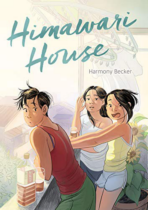
Living in a new country is no walk in the park―Nao, Hyejung, and Tina can all attest to that. The three of them became fast friends through living together in the Himawari House in Tokyo and attending the same Japanese cram school. Nao came to Japan to reconnect with her Japanese heritage, while Hyejung and Tina came to find freedom and their own paths. Though each of them has her own motivations and challenges, they all deal with language barriers, being a fish out of water, self discovery, love, and family.
This Light Between Us-a novel of World War II
In 1935, ten-year-old Alex Maki of Bainbridge Island, Washington, is horrified to discover that his new pen pal, Charlie Levy of Paris, France, is a girl, but in spite of his initial reluctance, their letters continue over the years and they fight for their friendship even as Charlie endures the Nazi occupation and Alex leaves his family in an internment camp and joins the Army.
They Called Us Enemy
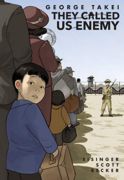
George Takei has captured hearts and minds worldwide with his captivating stage presence and outspoken commitment to equal rights. But long before he braved new frontiers in Star Trek, he woke up as a four-year-old boy to find his own birth country at war with his father’s — and their entire family forced from their home into an uncertain future. In 1942, at the order of President Franklin D. Roosevelt, every person of Japanese descent on the west coast was rounded up and shipped to one of ten “relocation centers,” hundreds or thousands of miles from home, where they would be held for years under armed guard. They Called Us Enemy is Takei’s firsthand account of those years behind barbed wire, the joys and terrors of growing up under legalized racism, his mother’s hard choices, his father’s faith in democracy, and the way those experiences planted the seeds for his astonishing future. What does it mean to be American? Who gets to decide? When the world is against you, what can one person do? To answer these questions, George Takei joins co-writers Justin Eisinger & Steven Scott and artist Harmony Becker for the journey of a lifetime.
They Called Us Enemy has been discussed in My Take/Your Take for August 2020.
They Called Us Enemy has been featured as a WOW Recommends Book of the Month.
The Turn Of The Tide
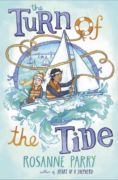
After a devastating tsunami in Japan, cousins Jet and Kai spend the summer together in Astoria, Oregon, training for the Young’s Bay Treasure Island Race and become close friends in the process.
Hunt for the Bamboo Rat
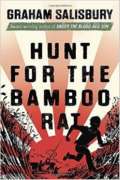
Zenji Watanabe, seventeen, is sent from Hawaii to the Philippines to spy on the Japanese during World War II and, after he is captured and tortured, must find a way to survive months of being lost in the jungle behind enemy lines.
The Four Immigrants Manga : A Japanese Experience In San Francisco, 1904-1924
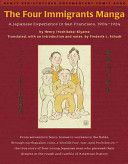
A “documentary comic book” from 1931, depicting the true adventures of four young Japanese men in America.
See the review at WOW Review, Volume VI, Issue 4
The Favorite Daughter

A father helps his daughter find pride and inspiration in this masterful picture book.Yuriko hates her name when the children make fun of it and call her “Eureka!” Though she is half Japanese, the teasing makes her want to hide, to retreat even from the art projects she used to love. Fortunately she has a patient, kind father who finds gentle ways of drawing her out and reminding Yuriko of the traditions they share that have always brought her joy: walks in lovely Golden Gate Park, lunch at their favorite sushi restaurant, watching the fog blow in off the bay. It’s enough… it’s more than enough to face down her challenges with confidence.From the incomparable Allen Say comes another moving story taken from his personal experience and translated to the universal. This tale, dedicated with love to Say’s daughter, is one for all parents who want their children to feel pride in their heritage, and to know their own greatest sources of strength and inspiration.THE FAVORITE DAUGHTER will be a favorite for years to come.
Kira-Kira (Newbery Medal Book)
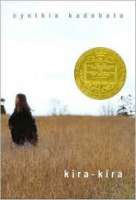
kira-kira (kee’ ra kee’ ra): glittering; shining
Glittering. That’s how Katie Takeshima’s sister, Lynn, makes everything seem. The sky is kira-kira because its color is deep but see-through at the same time. The sea is kira-kira for the same reason. And so are people’s eyes. When Katie and her family move from a Japanese community in Iowa to the Deep South of Georgia, it’s Lynn who explains to her why people stop them on the street to stare. And it’s Lynn who, with her special way of viewing the world, teaches Katie to look beyond tomorrow. But when Lynn becomes desperately ill, and the whole family begins to fall apart, it is up to Katie to find a way to remind them all that there is always something glittering — kira-kira — in the future.
Luminous in its persistence of love and hope, Kira-Kira is Cynthia Kadohata’s stunning debut in middle-grade fiction.
Name Me Nobody
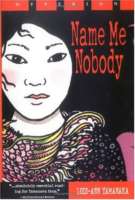
Fourteen-year-old Emi-Lou Kaya feels like a nobody in her Hawaiian town. Abandoned by her mother at age three, Emi-Lou hasn’t a clue as to who her father might be, and on top of all this, she is overweight. Her only salvation is the strength of the hard-as-nails but loving grandmother who raised her, and the feisty spirit of her best friend Yvonne. It is Yvonne who renames the dynamic duo Von and Louie, and who puts Emi-Lou on a strict weight-loss regimen. But Emi-Lou starts to worry about losing her touchstone when Von begins spending a little too much time with Babes, an older girl from the softball team. Rumors abound that her soul sister is a “butchie,” and when Emi-Lou suspects it’s true, she becomes desperate to get Von back to “normal” and back to her role as best friend.
